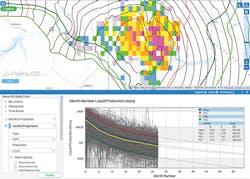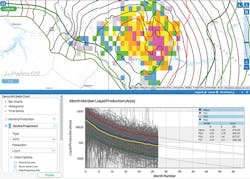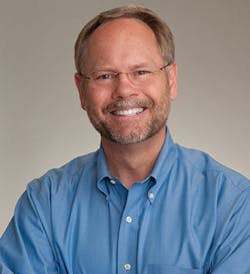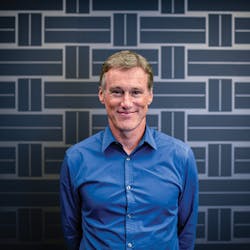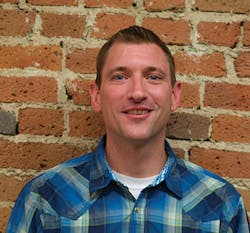Exciting times in oilfield technology
THE SECOND WAVE OF INNOVATION IN THE OIL PATCH
JAMES CONSTAS, PRISM GROUP, DENVER
IT IS SOMETHING of a conundrum that although the oil and gas business is highly dependent on technology, the industry is typically slow to adopt the latest innovations. The reasons are many, including inertia, the fear of fixing something that isn't broken or simple complacency. Given the large sums of capital at risk in the oil business, avoiding uncertainty is understandable. However, sometimes being just "good enough" is the enemy of making advancements in productivity, cost savings, and improving financial returns.
Since the shale revolution began in 2006, the industry has readily adopted innovations in hardware technology needed to drill and complete horizontal wells to develop resource plays. Powerful top drives, high pressure mud pumps, "walking" rigs and other improvements in oilfield equipment were rapidly developed and deployed into service. These improvements have reduced drilling days, and increased recoveries.
The numbers tell a compelling story. The US Energy Information Agency (EIA) measures drilling productivity using "new-well production per rig" for both oil and natural gas wells. EIA reported that new-well oil production per rig for the United States in December 2016 was 946 barrels of oil per day, which was 43% higher than the same month in the previous year, and an astonishing 774% higher than January 2007 at the start of the shale revolution.
Ironically, the down cycle has been a driving factor in the adoption of technology-based solutions in the oil industry. When oil prices were high, it was relatively easy to generate a return and there was little incentive to try something new. Operators scrambling to drill as many wells as quickly as possible saw logistics as their strategic priority for generating shareholder returns.
In the low price environment faced by the industry since summer 2014, however, there is a strong incentive to try new methods and ideas for reducing risk, improving efficiency and maximizing productivity, all of which improve profitability and returns. Increasingly, the industry is turning to information technology to make future productivity gains.
If the first wave of innovation was based on improving "dumb iron," then this second wave of innovation is about using smart information technology to do things faster, better, and more productively. In the field, operators are improving recoveries by using technology-based solutions to drill more accurately and optimize completions. At headquarters, business development teams are leveraging cloud-based solutions to identify and act on new prospects in days, rather than weeks or months.
These are exciting times, and we reached out to some of the entrepreneurs leading the second wave of innovation in the oil patch to find out what we can expect over the next several years.
PROSPECTING WITH BIG DATA
Oil and gas companies have been working with large amounts of data for decades, using both proprietary and licensed data sources, and those already massive data sets are getting bigger every day. The problem is, much of this data is stored in disparate databases, unable to be used as one seamless application without expending significant time and cost. That's a big problem for companies wanting to leverage Big Data.
A business development professional, for example, typically has to download information from multiple databases, reformat it, and then upload the combined file into a separate application for analysis and mapping. That task alone can take days. Ask a question during a meeting, and it might take another week to get the answer in the form of an updated map or financial analysis.
Alan Lindsey, CEO of Denver-based PetroDE asked the question, "Given the amazing breakthroughs in mapping and cloud technology, we asked why was it easier to use a cell phone to find a place for coffee than find a particular oil well and see it on a map? Why could we map a route to someone's office but not easily map statistics on production?"
"We knew there had to be a better way for operators to view and analyze geospatial data," continued Lindsey. "In addition to the collaboration benefits of cloud computing, our patented data processing engine works to compress time by connecting disparate data sets and then processing the data at lightning speed. By seamlessly linking both licensed and operator-owned proprietary databases, our solution eliminates significant amounts of wasted time. With our proprietary data processing algorithms, operators can render high-quality images and maps of production, IPs, available leases, and other key variables in minutes, as compared to days or weeks using legacy methods."
LANDING THE PRIZE
Once a team has decided to enter a particular play or pursue an infrastructure project, the leases and rights of way must be secured. That's the job of the landman.
For decades, the life of the landman was to rise early in the morning, slug down some coffee and be on the steps of the county recorder's office before the doors open. Manual inspection of leases and other legal documents was essential to create a title abstract, and a particularly charismatic or knowledgeable Landman could often get favorable treatment from courthouse staff at the expense of his or her rivals. This hands-on, artisanal approach to securing the needed documents, however, was inefficient, slow and not always reliable.
Enter Brett Wisner, president and co-founder of Wizdom Land Solutions. Wisner recalled, "Title examination was past due for disruption. The only reason I didn't start Wizdom Land sooner was because I kept on believing someone else would provide the solutions."
"When I started as a title examiner back in 2004, the process was straight forward," Wisner continued. "You would hop in your car, travel all over the country, check into your hotel and make sure you were at the courthouse when the doors opened. With a yellow legal pad and pen for notes, you would begin pulling book after book filled with deeds, leases, and mortgages that told the entire history of your parcel of land. Then, you would go back to your hotel room, fire-up your laptop and type your findings into a Word document and send your mineral and leasehold ownership report to the client. The reports would be printed, and stored in a file cabinet or on a hard drive somewhere. This process is incredibly slow, expensive, and ripe for error."
"Using our solution, landmen can do in two or three days what used to be a two to three-week process," added Wisner. "Our platform transforms the hand-crafted process of developing a title abstract into a workflow process that can be managed, measured, and it delivers a higher-quality product that is more reliable."
COMPLETING THE LAST MILE (OR TWO)
Once you have the mineral rights leased, the next step is to drill, complete and produce your first well. Drilling "two miles down and two miles out" is the model for resource play development, as operators drive the bit down to the objective, and then horizontally through the pay zone. Drilling the wellbore, however, is just the beginning. Unconventional oil and gas reservoirs require hydraulic fracture stimulation to produce economic volumes of oil and gas, which makes the Completions Engineer one of the most important people on the asset team.
Leading operators continue to report completing wells with more frac clusters and stages to expose more reservoir rock to the wellbore. The approach to spacing those clusters and stages, however, has been relatively uninformed by the geological variability known to exist along the wellbore, with perfs and stages placed at equal intervals, such as every 150 to 250 feet.
Engineers use equidistant spacing not because it is the best method, but because until now they have not had reliable information on rock properties along the horizontal leg of the well to justify anything different.
Chris Neale, CEO and founder, started FractureID to give completions engineers the tools for more precisely locating frac clusters and stages. Neale explained, "In the early days of resource play development, the emphasis was on generating efficiencies by doing the same thing across a large number of wells. That worked when oil prices were high, but the downturn put more attention on individual well results instead of statistical averages over a large drilling program."
"Nature is complex," Neale elaborated. "At FractureID, we invented new ways to measure and analyze the vibrations associated with the drill bit breaking or fracturing rock as it drilled through the reservoir. That technology gives us high-resolution measurements of critical rock properties at a fraction of the cost of conventional wireline logs, which we use to help customers locate frac perfs and stages in places where they will have the most impact. Our solution helps operators optimize their completions, increase hydrocarbon recoveries and reduces the waste incurred with the current 'carpet bomb' approach. Combined, those benefits improve financial returns."
BREAKING ANALYSIS PARALYSIS
The EIA estimates that at the end of 2015, the most recent year for data that is available, more than 300,000 hydraulically fractured wells had been drilled and completed in the United States, and those wells accounted for just over half of total domestic crude oil production. The job of analyzing the massive amounts of available data gets more difficult with every gigabyte streamed in from the field from every active frac spread in the country. However, this Herculean task offers a potential treasure trove of information for optimizing well completions.
Analyzing well performance has become an industry upon itself. Senior management and the investment community give preference to those operators who demonstrate they are moving the decline curve up a notch every year.
One company, Well Data Labs, has developed a solution to analyze and report frac data in minutes, instead of hours. Joshua Churlik, CEO and co-founder, explained, "Analyzing, reporting, and integrating measured completions data is essential to using big data techniques to spot patterns early, optimize completion designs and learn from historical operations. The old way of manually entering data into a spreadsheet is time consuming, expensive, and prone to error. Our solution builds on the high-resolution, one-second frac van data files to help engineers graph and report data in minutes."
"Much of our value proposition is that we allow operators to ask more questions and make better decisions with accessible data," Churlik continued. "Our technology gives both completion engineers and managers a nearly instant view of what is happening during a frac job by improving legacy workflows with modern software. This allows engineers to do what they do best while seamlessly moving quality completions data to an operator's back-office data systems."
BARRIERS TO ADOPTION
The old saying goes that "build a better mousetrap, and the world will beat a path to your door." In business to business sales, however, that axiom does not always hold true. Even with meaningful value propositions, energy tech companies face barriers to adoption, and surprisingly one of them is a common desktop application.
"Excel is our biggest competition," remarked Josh Churlik. "Most of the time our customers are storing, managing, and analyzing data in spreadsheets, and it can be difficult to get them to pull away from it. We've found the most effective approach to encouraging adoption is to simply ask customers to continue using their legacy spreadsheets side by side with our solution. Experience proves that once they discover how much faster and easier it is to do things on our platform, they stop using the spreadsheets."
Other barriers include simple resistance to change. Brett Wisner with Wizdom Land added, "The landman is typically a very individualistic personality, usually set in his or her ways. For us, the key is making our software easy to use and mirroring the way landmen think and work. We don't assume that there is only one best workflow to follow, and giving land professionals the ability to work the way they are used to working improves not only adoption, but it makes our solution sticky."
"Our biggest barrier to adoption is a client's current business practices," said Chris Neale with FractureID. "People are busy, and they often don't feel that they have the time to try something new. Thoughtful management, however, knows they can't take anything for granted. One of our more forward-thinking clients told us that the next level of efficiency gains will be based on high-resolution data, which is what we offer. If operators are going to make money at today's commodity prices, they know they have to do things different."
- Chris Neale, FractureID
A CAPITAL IDEA!
The oil and gas business has always been home to entrepreneurs, often charismatic risk-takers who seem to create value by sheer force of will. Having a vision, the technical expertise and the persistence to pursue it are vital qualities in getting an innovative business off the ground, but capital is needed too. When it comes to funding, many second wave energy tech firms have used a combination of bootstrapping and venture capital to fill the balance sheet with the financial fuel they need to advance their business plans.
All the energy tech entrepreneurs we interviewed said they started out by bootstrapping their companies with savings and money raised from friends and family. At some point, however, each found it necessary to raise capital from outside sources to advance their growth plans.
We met up with Jim Thorson, founder of Free Radical Ventures at the Denver Energy Tech Showcase, an exhibition of 18 up-and-coming energy tech firms. When we asked what kinds of companies he invests in, Thorson said, "I'm looking for companies that are solving specific problems in the industry - solutions for data management, improving completions, drilling better wells - things like that. There is money to be made by helping a team leverage an expertise or insight into a solution to a problem faced by all industry players."
Thorson and other venture investors are looking for commitment and market validation. He continued, "A startup team that has bootstrapped and acquired a few customers is a huge plus. If a company has customers, even one or two, that reduces the opportunity risk and provides some comfort that there is a real need being satisfied. Typically, an entrepreneur raises his or her first round from one or more of the 'Three Fs' - Friends, Family and Fools. Once they get a few customers and some cash flow, a seed investor can help bridge them to their first meaningful round of venture capital."
ADVICE TO FUTURE OIL AND GAS ENTREPRENEURS
Seasoned entrepreneurs can lend some insight to those thinking of starting their own company. Hard work is necessary, but listening is cited as the most essential element of leading a successful venture.
"Learn as much as you can from clients and potential clients," said Alan Lindsey. "Have a passion for alleviating the pain of others by solving their problems. Never forget that your success is a direct function of how well you eliminate your customers' pain."
Chris Neale advised, "Know your market. You can't just invent something without addressing a real need. I tell my people that the market whispers to them every day, be willing to listen to your customers and their problems, that's where the most commercial ideas are going to come from."
Wisner concurs, "Know the problem you are trying to solve, and get out from behind your desk and talk to customers, prospects and the industry. They will tell you what they need, if you are willing to listen."
Churlik added, "Having hands-on experience with the problems you are trying solve is critical, not only for developing a solution, but also for connecting on a peer-to-peer basis with customers."
ABOUT THE AUTHOR
James Constas, president and co-founder of Prism Group has more than 25 years of professional experience, primarily in oil and gas, management consulting, investor relations, financial analysis and planning, branding and marketing. He received his BS in International Management from Arizona State University and an MBA from the University of Denver.
